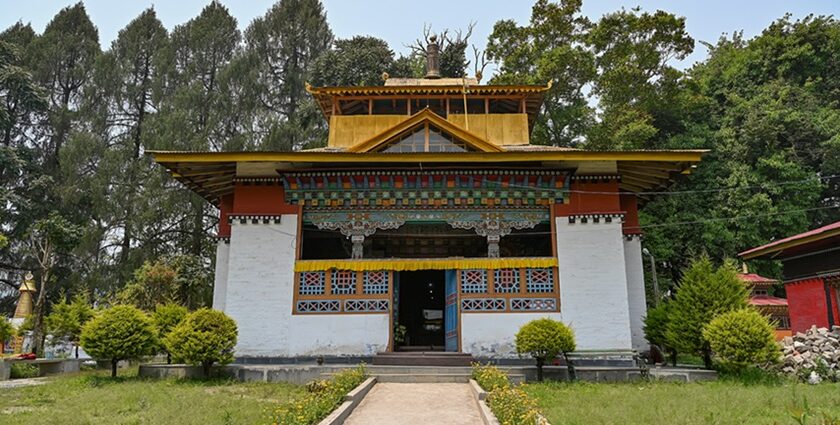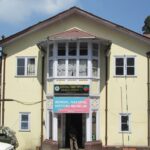The Tashiding Monastery in Gangtok is a peaceful and spiritual retreat that offers views of the Himalayas. This path to Tashiding feels like a pilgrimage with bright prayer flags and colourful paintings depicting tales of Buddha and other Buddhist gods. It is filled with detailed carvings and topped with multi-coloured prayer flags, which it usually attracts for a spiritual experience in this classic monastery. Thongwa Rangdol Chorten is a golden monument placed inside the monastery, and it is believed to purify all the sins of human beings.
Tashiding Monastery Location
Photo: Prof Ranga Sai / Wikimedia Commons
Tashiding Monastery is located in the West district of Sikkim, India. It is situated on a hill with stunning mountain views. The nearest town is Tashiding, which is approximately 36 kilometres away from Pelling.
Suggested Read: Your Complete Guide For Trekking In Gangtok
How To Reach Tashiding Monastery
Photo: Nui MALAMA / Unsplash / Image For Representation Only
The monastery can be conveniently reached via road from Bagdogra International Airport or New Jalpaiguri Railway Station in West Bengal.
By Road: This is the most common way to reach Tashinding Monastery. Visitors can drive their car or hire a taxi from nearby towns like Gangtok, Pelling, or Geyzing.
- From Gangtok, the drive is approximately 98 kilometres and takes about 3-4 hours.
- From Pelling, it’s a shorter distance of about 36 kilometres, taking approximately 1 hour and 34 minutes.
- Geyzing is another option, located 26 kilometres away with a travel time of roughly 1 hour and 13 minutes.
Places To Visit Around
The Tashiding monastery in Gangtok, Sikkim, is serene and peaceful. There are various places to visit in and around Tashiding Monastery.
1. Pemayangtse Monastery
Photo: Aakash.gautam / Wikimedia Commons
The Pemayangtse Monastery, established in the 17th century by Lama Lhatsun Chempo, is a special place in Pelling. It has a long history and beautiful art, with its red walls and layered roofs decorated with detailed carvings. Inside, people can feel a sense of importance, seeing how the monastery is built and the firm belief of the Sikkim royal family. The monastery’s museum displays old items, such as royal clothes, unique masks, and old religious texts, which share stories about the Sikkim royals and their dedication to Buddhism.
Timings: 10 AM – 5 PM
Entry Fee: ₹20
Suggested Read: Offbeat Places Near Gangtok
2. Rabdentse Ruins
Photo: Amritendu Mallick / Wikimedia Commons
The Rabdentse Ruins display a kingdom’s history, power, and rise and fall. These ruins give us a look into Sikkim’s royal past, showing detailed carvings and well-placed watchtowers that tell us about the lifestyle of the old royal court. The ruins also connect us to the stunning beauty of Sikkim, offering expansive views of snowy mountains, green valleys, and the impressive Kanchenjunga mountain range. Visiting these ruins is like travelling through time and admiring the skill of the architecture.
Timings: 10 AM – 5 PM (every day except Friday), 10 AM – 4 PM (Friday)
Entry Fee: Free
3. Kanchenjunga Falls
Photo: Sujay25 / Wikimedia Commons
Kanchenjunga Falls is a hidden gem that combines water’s power with the Himalayas’ serenity. The waterfall, a 100-foot veil of crystal-clear water, is a symphony of nature, washing away stress and leaving visitors feeling invigorated. The journey to the falls is an adventure, with a winding road adorned with colourful prayer flags and picturesque landscapes. For the adventurous, a ropeway offers a thrilling perspective, while for those seeking a more contemplative experience, a well-maintained path leads to a viewing platform.
Timings: 24*7
Entry Fee: ₹ 20
Suggested Read: Top Places To Visit In East Sikkim For An Incredible Experience
4. Buddha Park
Photo: Joydeep / Wikimedia Commons
In Ravangla, Buddha Park is a peaceful retreat in the Himalayas with a 130-foot-tall Gautama Buddha statue. It is an expanse of green, with soothing walking paths and a centrally located fountain accompanied by prayer flags with wishes. The golden hues of the statue reflect the feeling of inner peace, and in the backdrop, the mightiness of the Himalayas presents itself in all its majesty. Other than its aesthetic value, it also encompasses a museum with paintings elaborating on the life of Buddha.
Timings: 9:00 AM – 6:00 PM
Entry Fee: Free
5. Sanga Choeling Monastery
Photo: Anjan Kumar Kundu / Wikimedia Commons
The Sanga Choeling Monastery is an oasis of serenity and mystery. The monastery dates back to the 17th century when Lama Lhatsun Chempo built it. In literal translation, the name means the “place of secret spells,” as esoteric mantras have been practised there, the Guhyamantra. A sign outside its inner sanctum indicates that this is open only to Bhutias and Lepchas; thus, ancient practices will likely be preserved. The monastery, in traditional Tibetan style, merges with the rugged mountain backdrop; the prayer halls of this place are filled with mysterious symbols.
Timings: 9:00 AM – 5:00 PM
Entry Fee: ₹50
Suggested Read: Top Offbeat Places In Sikkim For Your Next Surreal Trip
6. Khecheopalri Lake
Photo: Yoghya / Wikimedia Commons
Khecheopalri Lake is a peaceful lake with many stories and beliefs. People think the footprint made it of a famous Buddhist saint, Guru Padmasambhava, and that its calm waters can make wishes come true. Birds keep the lake clean by removing leaves and showing their respect. The lake is peaceful for people looking for spiritual peace, with prayer wheels turning quietly and a calm atmosphere. Visitors can walk in the nearby forests, hike on green paths, and find hidden waterfalls or quiet open spaces.
Timings: 6 AM – 6 PM
Entry Fee: ₹20
Where To Stay
Photo: Andrea Piacquadio / Pexels / Image For Representation Only
Sikkim offers a plethora of accommodation facilities to pilgrims and travellers. Some popular ones are Norbulingka Retreat, Dzogchen Homestay, Tashiding Farmstay, The Elgin Mount Pandim, Udaan Olive Hotel & Spa and many more. Accommodations are available in various budgets; parking, Wi-Fi, and dining facilities are also provided in some accommodations.
Suggested Read: Discovering The Best Food In Gangtok
Where To Eat
Photo: Min An / Pexels / Image For Representation Only
Savour food in Lotus Bakery, Grains by Udaan PineCrest, Taste of Sikkim, Ramblers Cafe, Melting Point Restaurant and many more options are available; one is sure to get a good mix of local flavours and dishes familiar to all.
Best Time To Visit
Photo: Anjan Kumar Kundu / Wikimedia Commons
The Tashiding Monastery provides a memorable experience that combines spirituality and culture, especially from March to June, and offers pleasant weather and cultural immersion, coinciding with the Bumchu Festival. September to October offers quieter weather and lower prices, with fewer crowds and lower travel costs. September to October offers comfortable temperatures, lower accommodation and transportation rates, and better weather for sightseeing and exploring the monastery.
Suggested Read: Explore A Different Side Of Sikkim By Witnessing The Nightlife In Gangtok
Other Factors To Consider
Photo: Amitabha Gupta / Wikimedia Commons
Average Cost Of The Trip
There is an entrance fee at the Tashiding Monastery, around ₹50 to ₹100. Additional expenses may include transportation, offering items, food, and refreshments. The estimated cost would be from ₹ 2000 to 5000 per day.
Tips For Travellers
- Take care as a responsible traveller, and do not litter in the temple complex.
- Dress modestly—covering your shoulders and knees—since you will be entering places of worship.
- Show due respect to the local customs and traditions.
The Tashiding Monastery is an important Buddhist place of worship that provides a calm and culturally interesting visit. It is significant for the growth of Buddhism in this area, and tourists can visit places for meditation and other nearby attractions. The Tashiding Monastery is the quiet beauty of the Himalayas and the culture of Sikkim. With TripXL’s support, travelling to Tashiding Monastery becomes a memorable and enriching experience.
Cover Photo: Anjan Kumar Kundu / Wikimedia Commons


 WhatsApp
WhatsApp
 Twitter
Twitter



